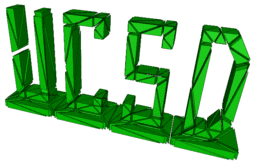| Michael Holst | ||
| https://ccom.ucsd.edu/~mholst/ |
Distinguished Professor of Mathematics and Physics UC San Diego |
|
|
Workshop on Algorithms for Macromolecular Modeling
SIAM News, Vol. 28 (March 1995), No. 3, p. 11. By Michael Holst, Ph.D. A workshop on algorithms for modeling macromolecules was held at the Kansas Institute for Theoretical and Computational Science at the University of Kansas in Lawrence, Kansas, Sept. 30 through Oct. 2, 1994. The workshop received support from both the Department of Energy's Office of Scientific Computing and the National Science Foundation's Computational Mathematics Program and DOE's Office of Scientific Computing. It was organized by Jan Hermans (University of North Carolina), Krzsysztof Kuczera (Kansas), Ben Leimkuhler (Kansas), and Bob Skeel (University of Illinois). More than 90 researchers from departments of biochemistry, physics, chemistry, biophysics, biomedical engineering, computer science, pharmaceutical science, and mathematics attended. Several participants came from industry and the national laboratories. The goal of the meeting was to bring modelers together with those developing numerical methods, software, and mathematical techniques, to exchange ideas about all aspects of macromolecular modeling. Major themes of the meeting included protein folding, fast calculation of long-range forces in many-body systems, the calculation of electrostatic interactions between a complex macromolecule and a solvent, constrained dynamics of large molecules, and the integration of quantum mechanical effects in classical molecular dynamics. Protein Folding Jan Hermans and Tamar Schlick (Courant Institute of Mathematical Sciences) opened the meeting with expository talks that touched on all the meeting themes. Schlick surveyed some new approaches to molecular dynamics time-stepping, describing various techniques such as the use of implicit methods to make larger timesteps possible. Several talks on protein folding followed. Peter Wolynes (Illinois) presented an overview, "Navigating the Energy Landscape of Protein," that illustrated both the excitement and the challenge of finding minimal conformations, a problem that has been likened to finding a hole in a golf course in the dark. Later, Zhijun Wu (Argonne National Laboratory) gave a talk entited "Continuation-Based Global Optimization for Molecular Conformation and Protein Folding." In the afternoon, Barry Honig (Columbia University) led off with a discussion of some applications of continuum electrostatic models of proteins and nucleic acids, followed by an analysis of the modeling of water around proteins by Montgomery Pettitt (University of Houston). Following the Friday afternoon poster session, the talks resumed with a discussion of the dynamics of rhinovirus by Carol Post (Purdue University). Carmay Li (University of Toronto) concluded the day by presenting an unusual approach to dynamic polymer modeling using cellular automata . Saturday morning began with Peter Kollman (University of California at San Francisco) lecturing on the calculation of free energy for complex molecular systems. Later in the morning session, Arieh Warshel (University of Southern California) discussed techniques for improving the accuracy of electrostatic energy calculations for a large solvated biomolecule, the electrostatic field of which is described by the Poisson-- Boltzman equation. Michael Holst (California Institute of Technology) discussed the use of parallel multigrid and domain decomposition for these types of problems. The participants then split into two groups for parallel sessions, which included a description by David Case (Scripps) of NAB, a computer language that aids in the modeling of nucleic acids, and an application by Mike Prisant (Duke University) of ray-representations to space-filling models of protein structure that involves the use of a special purpose massively parallel computer. Hon Chun (Moldyn Inc.) presented an novel approach to molecular modeling based on methods of multibody mechanical systems. Molecular Dynamics Simulations After lunch, Bernie Brooks (National Institutes of Health) gave an overview of computational techniques for the simulation of macromolecules. Ridgway Scott (Houston) described research on parallel methods for electrostatics problems arising in biophysics and in semiconductor modeling. John Board (Duke University) described the use of parallel fast multipole methods for rapid evaluation of coulomb forces; the evaluation of these long-range forces is one of the main difficulties in all molecular dynamics simulations. The meeting participants again broke into two groups for parallel sessions for the remainder of the day, which included a discussion of methods for constrained molecular systems by Eric Barth (Courant) and a talk by Lars Nyland (North Carolina) on parallel algorithms for molecular dynamics on shared memory multiprocessors. The lectures presented on Sunday morning focused on quantum effects in molecular systems. Paul Bash (Argonne) began with a discussion of modeling quantum effects in enzyme reactions with coupled classical/quantum models. Bogdan Lesyng (University of Warsaw) lectured on quantum-classical molecular dynamics models of macromolecules. The meeting concluded with a presentation by Alain St. Amant (University of Ottawa) of density functional methods for modeling large biological systems. The weather was wonderful in Lawrence, and the excitement generated by the lectures on Saturday was punctuated with a violent thunderstorm late in the evening. As Hermans and Schlick pointed out in their workshop-opening lectures, the modeling and numerical analysis problems arising in macromolecular dynamics are extremely challenging and will require new mathematical techniques, parallel computers, better physical models, and interdisciplinary communication and collaboration. The Lawrence workshop and others like it will help to facilitate these new approaches. Dr. Michael Holst is a von Karman Instructor of Applied Mathematics at the California Institute of Technology. |
